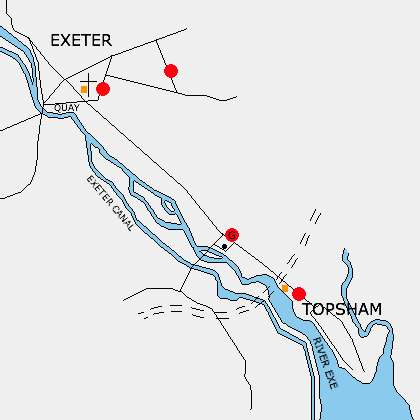1653-60 The Bishop's Palace was used as a sugarhouse by FORD.

1653-60 The Bishop's Palace was used as a sugarhouse by FORD.

1971 Excavations here revealed a quantity of sherds of sugar moulds and jars.

An industry linked to sugar refining here in late 17thC.

This was the site of the Topsham sugarhouse
abt1684-1723 BUTTALL Samuel & Sons
1723-25 BUTTAL Benjamin & John
1725-1740s HODGES & BUTTALL

EXETERCLICK the (For local directory of sugarhouses, click here.) (For national directory of sugarhouses, click here.)
The width of this map represents 5ml / 8km. |
 |
|
Refining in Exeter ... There certainly was some very early sugar refining in both Exeter and Topsham even though the evidence is slim ... 1650s ... In the Cathedral Close stood the Bishop's Palace - it had become rather down at heel in Elizabethan times. In 1647 it was sold to the Corporation, who in 1650 conveyed it to the Governors of St. John's Hospital, who "in 1653 leased it to one Ford, by whom it was occupied as a sugar-house"..."vestiges of it were found on making some alterations at the palace in February, 1821." His tenure was short though, for when the Monarchy was restored the Palace was purchased by Bishop Seth Ward who repaired and refitted it at great expense.(1)(5) I believe that the Bishop's Palace is the oldest remaining sugar refining building in the UK ...
1684 ... There was a glasshouse just up river from Topsham, and sometime after 1684 a sugarhouse was established in the same area. (Interesting that this is similar to Gloucester where glass and sugar production were in very close proximity to each other). "The refinery was owned by Samuel Buttall who had a sugar plantation in South Carolina. [He] opened the factory and later took his sons, Benjamin and John into partnership. His brother, Charles Buttall also supplied the factory from his slave plantation in Barbados. Samuel Buttall died in 1723 and his son-in-law, Sir Nathaniel Hodges took a half share in the business during 1725. The sugar house prospered for a few years, but by 1743 it was but a memory, having '...lain void for want of a tenant'. In 1744, Sir Nathaniel's wife, Lady Hodges sold the works as instructed by his will. It was at the end of the 18th century that the elegant Retreat House was built on the site."(2) 1756 ... Letters held at London Metropolitan Archives regarding the Eliot family mention that "On 5 October 1756 ..... the cellars by the dock [Topsham] were let to Dr. Glass for sugar pans as his pan near Exeter had been taken by the Government for French Prisoners."(3) 1971 ... "In the years between 1680 and 1720 several sugar bakers operated in Exeter and Topsham. The waste of one of their sugar houses was found in Goldsmith Street in 1971. ... The Exeter finds include thousands of sherds of sugar mould, which seem to have been imported from Portugal, alongside many fragments of the syrup pots."(4) There's an interesting image of moulds and pots accompanying this text on the website.
1. http://genuki.cs.ncl.ac.uk/DEV/Exeter/ExeterHist1850/Ecclesiastical.html |
|
|
|